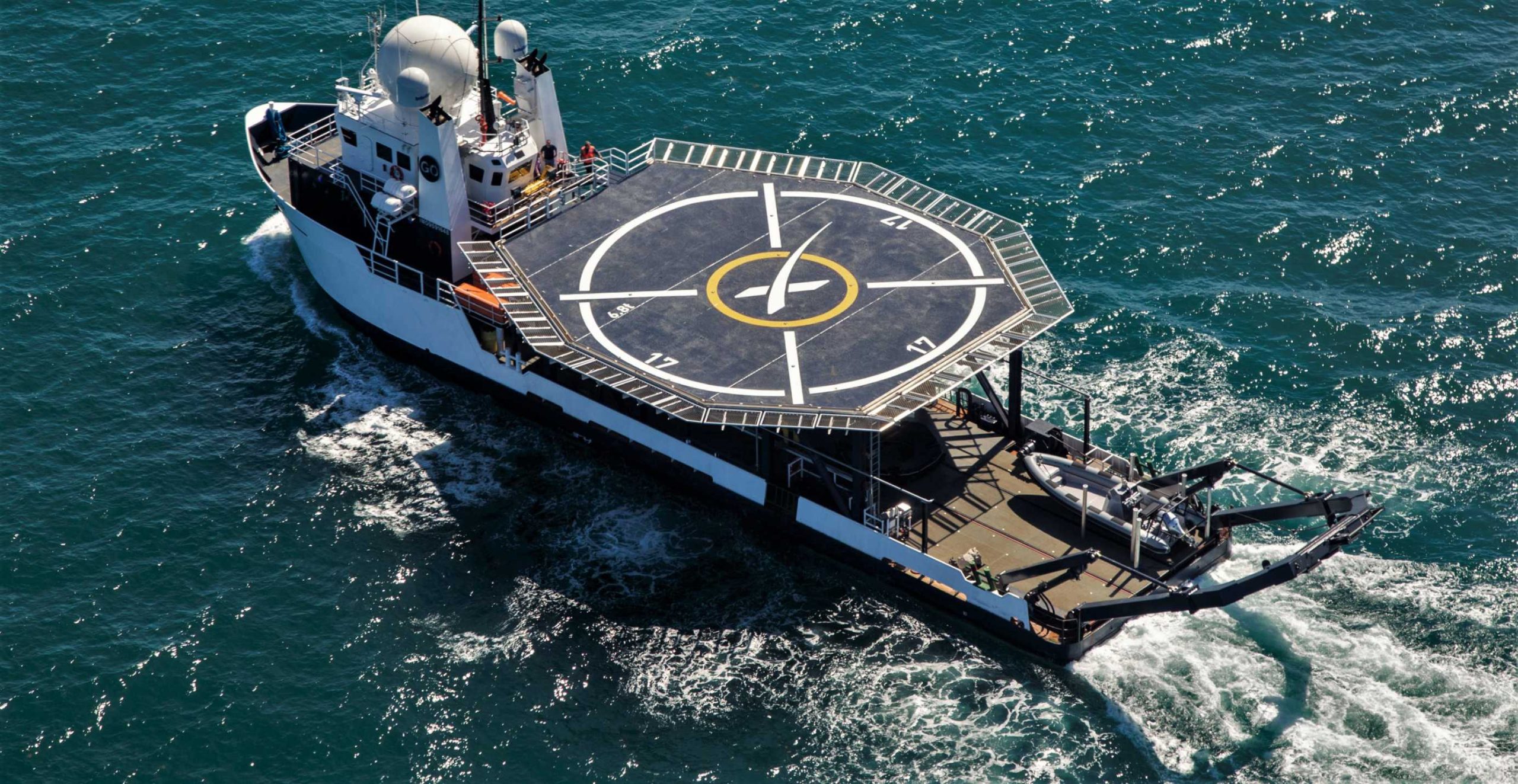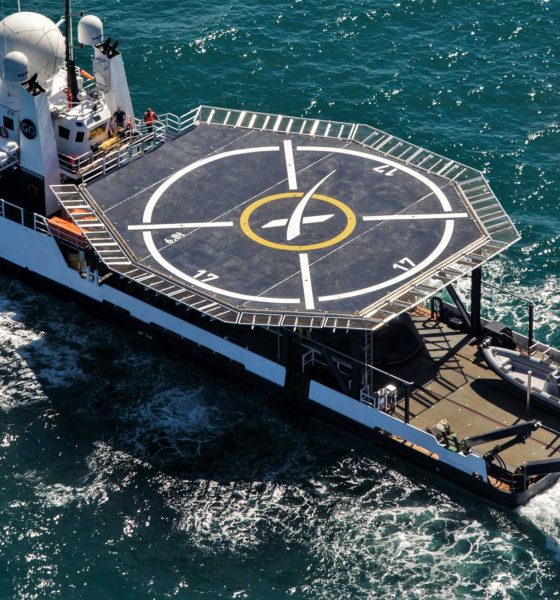

News
NASA shows off SpaceX’s upgraded Crew Dragon recovery vessel, tests helipad
SpaceX and NASA have completed test runs with the company’s Florida recovery fleet in preparation for Crew Dragon’s first orbital missions with astronauts aboard, ensuring that there is an infrastructure in place to rapidly transport astronauts to shore and deal with any potential medical emergencies that might arise.
X marks the spot where @SpaceX will land a helicopter at sea in the unlikely event they need to airlift astronauts to a hospital after Crew Dragon splashes down: https://t.co/dmUq4OgZz5 pic.twitter.com/wCmbKqGlWp
— NASA Commercial Crew (@Commercial_Crew) November 5, 2018
Over the past three months, SpaceX’s Florida marine engineers and technicians have extensively upgraded two recovery vessels that – while typically only accessories to Falcon 9 drone ship recoveries – will soon play mission-critical roles in Crew Dragon’s operational transport and recovery of NASA astronauts. Named GO Searcher and GO Navigator (GO stands for Guice Offshore, the owner and operator), the vessels will likely end up as twins to ensure redundancy – one ship breaking down cannot be allowed to significantly delay launch or recovery operations.
For Searcher and Navigator, their duties will include acting as major communications relays (evidenced by the recent installation of a large radome on Searcher), lifting several-ton Crew Dragon capsules aboard for hardware checkouts and astronaut offloading, verifying astronaut health with onboard medical facilities, and supporting a helipad for helicopter operations. Prior to Crew Dragon, SpaceX has used GO Searcher as a communications relay to gather Falcon 9 booster and fairing telemetry and sometimes act as a backup view for drone ship Of Course I Still Love You’s livestream attempts. It’s unclear if the vessel will continue to perform those tasks once Crew Dragon begins launch operations early next year.
- GO Searcher’s helipad was completed sometime in late August or September. Navigator is painted white. (Tom Cross)
- Crew Dragon approaches the International Space Station in this render. (SpaceX)
- An overview of the expected modifications needed to turn a Crew Dragon into a Cargo Dragon 2. (NASA OIG)
Aside from acting as a rapid bridge between Crew Dragon’s astronauts and the shore, GO Searcher (and perhaps Navigator) will also become a foundation of SpaceX’s next-gen Cargo Dragon 2 spacecraft when it takes over Cargo Dragon’s International Space Station (ISS) resupply role sometime in 2020. After recovery aboard GO Searcher or Navigator, Crew Dragon capsules will be refurbished and lightly modified for operation as Cargo Dragon, mainly involving the removal of crew-specific hardware inside the pressure section and the addition of Cargo-specific hardware and software.
By using Crew Dragon to also fulfill CRS-2 cargo missions, SpaceX is likely hoping to minimize the manufacturing infrastructure needed, removing the need for an entirely separate assembly line.
For prompt updates, on-the-ground perspectives, and unique glimpses of SpaceX’s rocket recovery fleet check out our brand new LaunchPad and LandingZone newsletters!

News
Tesla FSD fleet is nearing 7 billion total miles, including 2.5 billion city miles
As can be seen on Tesla’s official FSD webpage, vehicles equipped with the system have now navigated over 6.99 billion miles.

Tesla’s Full Self-Driving (Supervised) fleet is closing in on almost 7 billion total miles driven, as per data posted by the company on its official FSD webpage.
These figures hint at the massive scale of data fueling Tesla’s rapid FSD improvements, which have been quite notable as of late.
FSD mileage milestones
As can be seen on Tesla’s official FSD webpage, vehicles equipped with the system have now navigated over 6.99 billion miles. Tesla owner and avid FSD tester Whole Mars Catalog also shared a screenshot indicating that from the nearly 7 billion miles traveled by the FSD fleet, more than 2.5 billion miles were driven inside cities.
City miles are particularly valuable for complex urban scenarios like unprotected turns, pedestrian interactions, and traffic lights. This is also the difference-maker for FSD, as only complex solutions, such as Waymo’s self-driving taxis, operate similarly on inner-city streets. And even then, incidents such as the San Francisco blackouts have proven challenging for sensor-rich vehicles like Waymos.
Tesla’s data edge
Tesla has a number of advantages in the autonomous vehicle sector, one of which is the size of its fleet and the number of vehicles training FSD on real-world roads. Tesla’s nearly 7 billion FSD miles then allow the company to roll out updates that make its vehicles behave like they are being driven by experienced drivers, even if they are operating on their own.
So notable are Tesla’s improvements to FSD that NVIDIA Director of Robotics Jim Fan, after experiencing FSD v14, noted that the system is the first AI that passes what he described as a “Physical Turing Test.”
“Despite knowing exactly how robot learning works, I still find it magical watching the steering wheel turn by itself. First it feels surreal, next it becomes routine. Then, like the smartphone, taking it away actively hurts. This is how humanity gets rewired and glued to god-like technologies,” Fan wrote in a post on X.
News
Tesla starts showing how FSD will change lives in Europe
Local officials tested the system on narrow country roads and were impressed by FSD’s smooth, human-like driving, with some calling the service a game-changer for everyday life in areas that are far from urban centers.

Tesla has launched Europe’s first public shuttle service using Full Self-Driving (Supervised) in the rural Eifelkreis Bitburg-Prüm region of Germany, demonstrating how the technology can restore independence and mobility for people who struggle with limited transport options.
Local officials tested the system on narrow country roads and were impressed by FSD’s smooth, human-like driving, with some calling the service a game-changer for everyday life in areas that are far from urban centers.
Officials see real impact on rural residents
Arzfeld Mayor Johannes Kuhl and District Administrator Andreas Kruppert personally tested the Tesla shuttle service. This allowed them to see just how well FSD navigated winding lanes and rural roads confidently. Kruppert said, “Autonomous driving sounds like science fiction to many, but we simply see here that it works totally well in rural regions too.” Kuhl, for his part, also noted that FSD “feels like a very experienced driver.”
The pilot complements the area’s “Citizen Bus” program, which provides on-demand rides for elderly residents who can no longer drive themselves. Tesla Europe shared a video of a demonstration of the service, highlighting how FSD gives people their freedom back, even in places where public transport is not as prevalent.
What the Ministry for Economic Affairs and Transport says
Rhineland-Palatinate’s Minister Daniela Schmitt supported the project, praising the collaboration that made this “first of its kind in Europe” possible. As per the ministry, the rural rollout for the service shows FSD’s potential beyond major cities, and it delivers tangible benefits like grocery runs, doctor visits, and social connections for isolated residents.
“Reliable and flexible mobility is especially vital in rural areas. With the launch of a shuttle service using self-driving vehicles (FSD supervised) by Tesla in the Eifelkreis Bitburg-Prüm, an innovative pilot project is now getting underway that complements local community bus services. It is the first project of its kind in Europe.
“The result is a real gain for rural mobility: greater accessibility, more flexibility and tangible benefits for everyday life. A strong signal for innovation, cooperation and future-oriented mobility beyond urban centers,” the ministry wrote in a LinkedIn post.
News
Tesla China quietly posts Robotaxi-related job listing
Tesla China is currently seeking a Low Voltage Electrical Engineer to work on circuit board design for the company’s autonomous vehicles.

Tesla has posted a new job listing in Shanghai explicitly tied to its Robotaxi program, fueling speculation that the company is preparing to launch its dedicated autonomous ride-hailing service in China.
As noted in the listing, Tesla China is currently seeking a Low Voltage Electrical Engineer to work on circuit board design for the company’s autonomous vehicles.
Robotaxi-specific role
The listing, which was shared on social media platform X by industry watcher @tslaming, suggested that Tesla China is looking to fill the role urgently. The job listing itself specifically mentions that the person hired for the role will be working on the Low Voltage Hardware team, which would design the circuit boards that would serve as the nervous system of the Robotaxi.
Key tasks for the role, as indicated in the job listing, include collaboration with PCB layout, firmware, mechanical, program management, and validation teams, among other responsibilities. The role is based in Shanghai.
China Robotaxi launch
China represents a massive potential market for robotaxis, with its dense urban centers and supportive policies in select cities. Tesla has limited permission to roll out FSD in the country, though despite this, its vehicles have been hailed as among the best in the market when it comes to autonomous features. So far, at least, it appears that China supports Tesla’s FSD and Robotaxi rollout.
This was hinted at in November, when Tesla brought the Cybercab to the 8th China International Import Expo (CIIE) in Shanghai, marking the first time that the autonomous two-seater was brought to the Asia-Pacific region. The vehicle, despite not having a release date in China, received a significant amount of interest among the event’s attendees.












